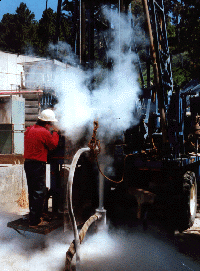Chill In a Drill
 Researchers in the Earth Sciences Division have put a
cool twist on the underground drilling used to clean up toxic waste sites. They
have invented a drilling technique that blasts super-cold nitrogen gas as it
bores, creating frozen holes that won't collapse even in the sandiest of soils.
Researchers in the Earth Sciences Division have put a
cool twist on the underground drilling used to clean up toxic waste sites. They
have invented a drilling technique that blasts super-cold nitrogen gas as it
bores, creating frozen holes that won't collapse even in the sandiest of soils.
 Nitrogen is injected down the drill's center pipe and exits through
nozzles near the spinning drill bit. At -196 degrees C, the gas freezes difficult
soils rich in sand, gravel or ash long enough for workers to insert stabilizing
metal casings into the holes before the ground thaws.
Nitrogen is injected down the drill's center pipe and exits through
nozzles near the spinning drill bit. At -196 degrees C, the gas freezes difficult
soils rich in sand, gravel or ash long enough for workers to insert stabilizing
metal casings into the holes before the ground thaws.
George Cooper in Earth Sciences developed the technology with Rafael Simon, a UC Berkeley
graduate student.
The cryogenic method should be valuable to researchers
trying to clean up contaminated grounds at many industrial facilities, closing
military bases, and Department of Energy weapons laboratories, where loose dirt
has often made it difficult to drill holes that do not cave in.
Boring holes in the earth is usually the first step in assessing contaminated areas.
Soil samples taken from the holes tell scientists the types of pollutants that
are present as well as their distribution. Drilling is also critical for
removing contaminants from the ground, which can involve pumping pollutants out
with groundwater or boiling them out with injected steam.
Unfortunately, cleanup experts at many facilities often find themselves faced with
crumbling
soils that will not support their holes.
Drillers at contaminated sites are at a particular disadvantage since they can't
use substances such as
"drilling muds," the clay-based goo that is used to help stabilize bore holes.
< One location where soil collapse has been an issue is the nuclear cleanup
site in Hanford, Washington, which sits on layers of loose gravel and sand.
Cave-ins have hampered attempts to analyze the soil beneath storage tanks that
were used to store radioactive waste.
"People have had difficulty
drilling vertical holes at Hanford, and those are the easy ones," Cooper says.
"To get to the soil beneath the tanks, you need to drill holes at an angle.
These are even less stable."
Cryogenic drilling should allow scientists
to drill the difficult holes at Hanford and other problem sites such as the
Savannah River site in South Carolina, Idaho National Engineering Laboratory,
and the Oak Ridge Reservation in Tennessee.
The method performs well in
other problem soils as well, such as the clay-rich dirts that clog up drill
bits. Clay soil is frozen hard by the nitrogen gas and is crushed by the drill
bit into rock-hard chips, which are blown out of the hole by the gas pressure.
"The nitrogen gas also has an advantage when it comes to sampling soil for
monitoring since the freezing locks the pollutants in," Cooper says. "Methods
that use water may wash some of the pollutants completely away. You may
seriously underestimate the level of pollution."
While engineers have
occasionally used cryogenic techniques to freeze soil before drilling, this is
the first time that soils are frozen at the same time they are drilled.
-- Mike Wooldridge
 Return to Highlights Table of Contents
Return to Highlights Table of Contents
 Nitrogen is injected down the drill's center pipe and exits through
nozzles near the spinning drill bit. At -196 degrees C, the gas freezes difficult
soils rich in sand, gravel or ash long enough for workers to insert stabilizing
metal casings into the holes before the ground thaws.
Nitrogen is injected down the drill's center pipe and exits through
nozzles near the spinning drill bit. At -196 degrees C, the gas freezes difficult
soils rich in sand, gravel or ash long enough for workers to insert stabilizing
metal casings into the holes before the ground thaws.  Researchers in the Earth Sciences Division have put a
cool twist on the underground drilling used to clean up toxic waste sites. They
have invented a drilling technique that blasts super-cold nitrogen gas as it
bores, creating frozen holes that won't collapse even in the sandiest of soils.
Researchers in the Earth Sciences Division have put a
cool twist on the underground drilling used to clean up toxic waste sites. They
have invented a drilling technique that blasts super-cold nitrogen gas as it
bores, creating frozen holes that won't collapse even in the sandiest of soils.